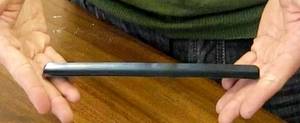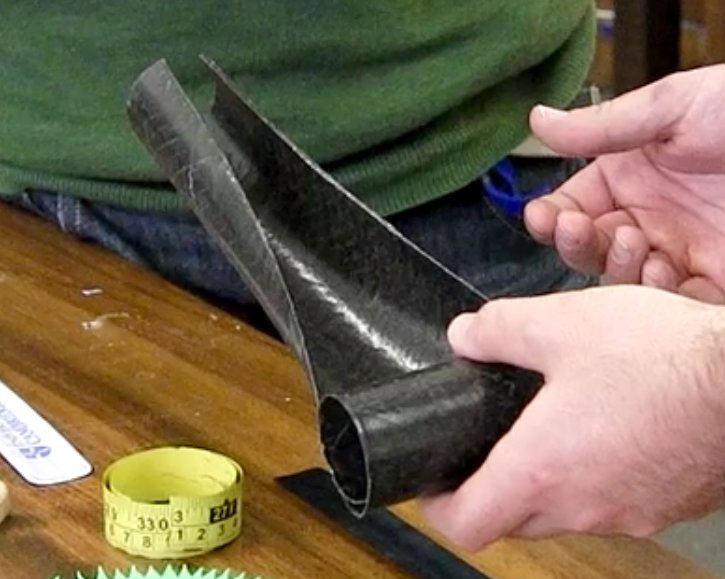Naked Engineering - Bistable Structures
Interview with
Meera - This week on Naked Engineering, Dave and I have returned to the Structures Lab in the engineering department here at the University of Cambridge, but this time, we're looking into shape changing structures. So, as the name suggests, these are structures that change their shape, but Dave, tell me a bit more about why these are so special?
Dave - If you're a conventional engineer building something like a bridge, or a car, or an aircraft carrier, you want it to do things which are very, very predictable. So you tend to use big lumps of solid materials which stay in one shape and you might have joints in between them but the actual materials themselves are always the same shape. And so, what we're looking at today is structures in which the whole structure can actually reconfigure itself and change shape.
Meera - And one person working with these structures is Dr. Keith Seffen who's from the Advanced Structures group here. Now Keith, you've got something most people are familiar in your hand, it's a snap bracelet...
Keith - Indeed it is, Meera. As you can see, it's got a little bit of plastic covering on it but it's predominantly straight or it is straight in one configuration, and if you flick it against your arm, it'll wrap around it and adopt a circular shape.
Dave - This has got two configurations. One where it looks straight but if you  look carefully at it, its curved in the other direction just very slightly. The second one is when you wrap it around your wrist and it's essentially just a straight coil in one direction.
look carefully at it, its curved in the other direction just very slightly. The second one is when you wrap it around your wrist and it's essentially just a straight coil in one direction.
Keith - That's right, Dave. If we take it apart, if we remove the plastic sheath, it looks like a tape measure. Straight in one configuration, but curved gently across its width and in the other configuration, wrapped up a bit like a tape measure, sitting inside a cassette spool.
Meera - So, this is something many of us have seen, but how does it actually work? How is it possible for it to have these two configurations?
Keith - Well your ordinary tape measure won't have this. It will just want to be straight. What you have to do is manipulate it. Create or embed the second shape; the desire to be curved.
Dave - So you're basically just distorting the metal itself, plastically deforming the tape.
Keith - What you can do if you can get hold of a length of the tape is to cut a length, wrap it into a coil, wrap it around a pencil perhaps, or your finger, and try and pull it as tightly as possible. What that does is to permanently deform the tape measure into the circular position. It likes to be in that shape, but if you then pull it straight, it will prefer to be in that shape as well, and that creates this bistable property, where it desires to be in both configurations at once.
Meera - So you've now rolled up this tape measure quite tightly around your finger and opened it up back up. So now, with just certain pressures or just pushing on certain points, it should just flick.
Keith - That's right. If you just take it and push in the middle, as you can see and hear, it sort of pops into the cylindrical configuration or the wrap-around configuration. And then you have to physically unravel it to create the straight structure again. What you need however is two very different shapes for this to work and in the case of a tape measure, it's long across its length but curved across its width, and that changes when you wrap it around your finger. When you wrap it around a pencil, it becomes flat across its width and coiled along its length, and it's that antagonism that permits the properties that you see. The shapes are so different that to physically move from one to the next, you have to come along and break it with your finger or push it in the right place.
Meera - Can this also be used in other types of materials as well?
Keith - Sure thing. We have different engineering materials; a popular lightweight structural material is carbon fibre, and we work closely with a company that make tubes from carbon fibre that have the same bistable property. I've got an example here of one where we've actually tuned the properties so that it prefers both to be straight and to be coiled at the same time whilst you're holding it, and we call that a neutrally stable structure.
 Dave - So, it's not snapping between one to the other. It's just moving very gently.
Dave - So, it's not snapping between one to the other. It's just moving very gently.
Keith - That's right. In the previous structures, there is a desire to be in both shapes, at the same time, they can only occupy one shape at a given time. Whereas this one can occupy both and it occupies both by having part of it straight and part of it coiled and a funny transition region in between.
Dave - I guess this is a really neat way of storing a very, very long tube. If you want a long tube or something, you can just roll it up the other way and it turns into a short, fat, easily storable object.
Keith - And in addition, because it's quite happy to be extended to any length, you can have a tube of any length and for that reason, imagine you wanted to have some kind of device that would enable you to look into buildings at particular height - so what you can do is extend the tube, have a camera on the top of it and then look into say, the window of a burning building if you're a fireman or whatever, but you don't want to be carrying this around in the extended configuration. So you'd roll it up and stick in your backpack, it'll quite happily fit there because it's coiled and neatly packed.
Meera - Is there anything else we can also use these structures for?
Keith - What these little demonstrations have shown you is that, crucial to the performance of these is what you start off with as a basic shape. With the snap bracelet, what we thought of doing was taking several of them and linking them together to produce something which was a bit wider, rather than having just a single strip, several strips next to one another, then we had the idea of alternating those strips. What you end up with then is something that looks a bit like a corrugated sheet. Like a flick bracelet where we're able to give it pre-stress, we can make the corrugated sheet which is nominally flat, coil up into a cylinder.
Dave - This is actually a really quite nice design. Basically, it's a whole series of these tape measures next to each other, but one upside down and one in the right way up. But instead of separate tape measures, it's all just made out of a single sheet of metal which has been bent. And this means, that because it's actually got some depth, it's actually reasonably rigid as a flat sheet, but if you bend them beyond that point, it just starts to roll up into a tube, about 2 inches in diameter. And now, it's still quite a solid structure, but it's rolled up and takes up so much less space.
Keith - What this demonstrates is a very simple mock up of an application of our technology where you might want to give some support to a very flexible, thin electronic display. There are people out there in the electronics industry, trying to make displays as thin as possible to give them this nice, flexible feature. Electronic ink, electronic newspaper, but delicate structures nonetheless. What we're thinking is we'll put one of our sheets on the back of it to give it some strength and stiffness, but at the same time, not removing that rollability, that foldability, of the display or what it's offering, and at the same time, offering protection to the structure.
Dave - You could basically have a computer screen which is the size of laptop screen but protected because it's got this nice strong back that sits nice and flat, but when you click it, it will then roll up into something 2 inches across, you can put in your pocket. But it's still quite protecting. It's got this big metal sheet on the back and you can't crease it.
Meera - And so, with applications like this Keith, so eBook readers and electronic tablets, they're all very popular at the moment, and so in the future, we could just have thinner, more portable ones that would fit quite neatly into our bags and be protected.
Keith - I think that's where the industry might be heading. The thinner the display, the lighter it is, the less power it uses, but the more delicate it becomes, so you need some kind of protective backing in these and one that enables or imparts the shape changing capability that makes it easier to put in your pocket or wherever is something that would help.
Sarah - That would certainly make working on the move a lot better if you could just roll up your laptop and put it in your pocket. That was Dr. Keith Seffen from the University of Cambridge, talking to Meera Senthilingam and Dave Ansell for this week's Naked Engineering.









Comments
Bistable Structures
Hello. I recently viewed a youtube video you posted on Bistable Structures. One of the materials used during this interview was the corrugated sheet (seen at 0:13 on the video). What material was this sheet made from? Also, where would I be able to get this material?
Add a comment